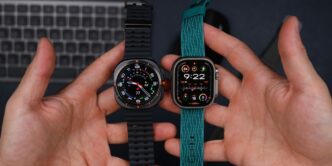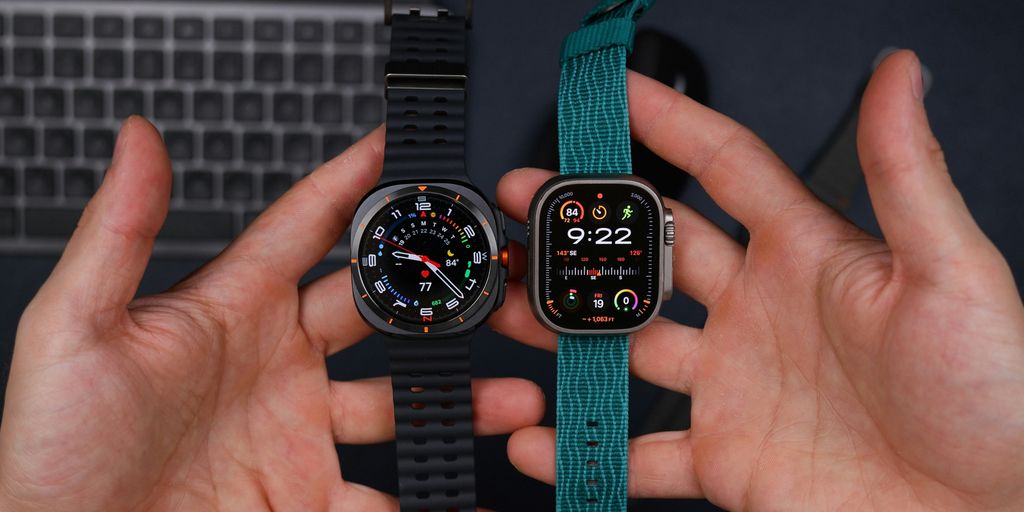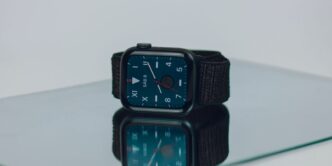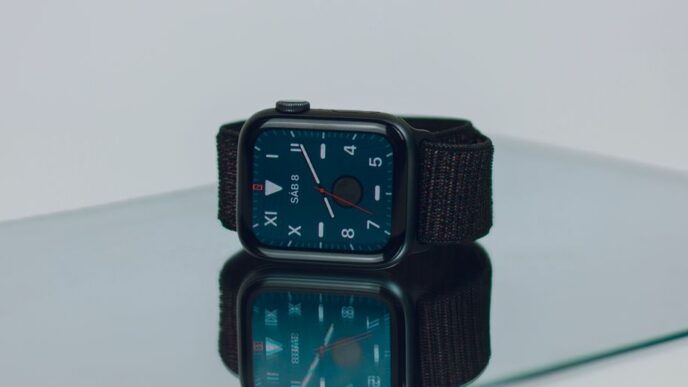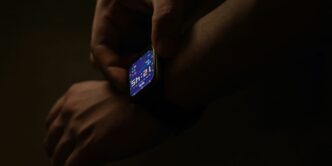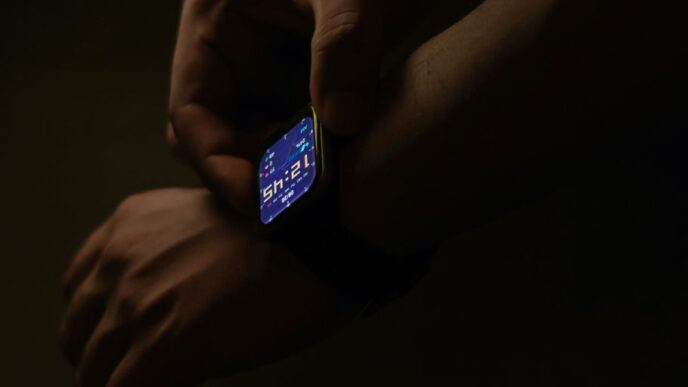So, you’re trying to figure out which smartwatch is the best one to get in 2025, right? It really comes down to two big players: Garmin and Apple Watch. They both do a lot of cool stuff, but they’re aimed at slightly different people. We’re going to break down the main differences to help you decide which one makes more sense for your life.
Key Takeaways
- Garmin often appeals more to serious athletes and outdoor adventurers with its deep fitness metrics and long battery life.
- Apple Watch is a top choice for those already in the Apple ecosystem, offering smooth connectivity and a wide range of apps.
- When it comes to tracking workouts, especially using GPS, Garmin generally lasts much longer on a single charge.
- For everyday health monitoring and smart features like notifications and calls, the Apple Watch usually provides a more integrated experience.
- Both brands update their software regularly, but Garmin tends to focus on fitness improvements, while Apple adds broader features and app support.
Garmin vs Apple Watch: Core Differences
When you’re trying to figure out which smartwatch is the right fit, Garmin and Apple Watch are usually the top two contenders. They’re both really good, but they go about things a bit differently, aiming at slightly different people. It’s not just about what they look like; it’s about who they’re built for and what you get for your money.
Target Audience Insights
Garmin watches tend to attract folks who are really into sports and outdoor activities. Think runners, cyclists, swimmers, hikers – people who need precise data for their training and adventures. They often have a more rugged feel and are built to handle tough conditions. If you’re someone who spends a lot of time tracking specific workouts or exploring trails, a Garmin might feel more natural. They’re designed with the athlete in mind, providing detailed metrics that help you push your limits. For example, Garmin’s multi-band GNSS is a big deal for accuracy in tricky spots, which is something many outdoor enthusiasts really appreciate when they’re out exploring new routes.
On the other hand, the Apple Watch is more of an all-arounder, fitting nicely into the everyday lives of many people, especially those already in the Apple ecosystem. It’s great for general fitness tracking, health monitoring, and, of course, all the smart features like notifications, calls, and apps. If you want a device that keeps you connected, helps you manage your day, and also tracks your steps and workouts, the Apple Watch is a strong choice. It’s less about extreme sports and more about integrating technology into your daily routine.
Return on Investment Considerations
Thinking about the cost, both brands have a range of prices, but generally, you’re looking at different value propositions. Garmin often packs a lot of specialized sports features into its watches, which can justify a higher price point for serious athletes. The durability and the depth of sport-specific data can mean it lasts longer for your training needs.
Here’s a quick look at what you might expect:
| Feature Category | Garmin Focus | Apple Watch Focus |
|---|---|---|
| Primary User | Athletes, Outdoor Enthusiasts | General Users, Tech Enthusiasts |
| Key Metrics | Advanced Sport Data, GPS Accuracy | Health Monitoring, Daily Activity |
| Ecosystem | Standalone Fitness Powerhouse | Deep Integration with Apple Products |
| Durability | Often more rugged, built for outdoors | Varies by model, generally good for daily use |
Apple Watch, while also a significant investment, offers a lot in terms of its smart capabilities and how well it works with your iPhone, iPad, and Mac. The value here comes from its versatility and the constant stream of new features and app integrations through software updates. For many, the convenience and connectivity it provides are well worth the price, even if they aren’t training for a marathon.
Fitness and Health Tracking Capabilities
When it comes to tracking your workouts and keeping tabs on your health, both Garmin and Apple Watch have their own ways of doing things. It’s not just about counting steps; it’s about the details that help you understand your body better.
Garmin’s Athlete-Centric Metrics
Garmin really leans into the data side of things, especially for people who are serious about their training. They pack in a ton of specific metrics that athletes often look for. Think about things like VO₂ max, which is a measure of your aerobic fitness, or detailed heart rate zones that help you train in the right intensity. Garmin watches often provide a "Body Battery" score, which is basically a gauge of your energy levels throughout the day, taking into account your activity and rest. It’s a neat way to see how recovered you are. They also have pretty in-depth sleep tracking, looking at different sleep stages and even offering personalized advice. For example, the Venu 3 can even factor in daytime naps, which is pretty unique. They’ve also made strides in inclusivity, with modes for wheelchair users tracking pushes instead of steps. Garmin’s strength lies in providing a deep well of physiological data that can really help serious athletes fine-tune their training.
Apple’s Comprehensive Health Suite
Apple Watch, on the other hand, has built a really solid health and fitness system that’s super user-friendly. It tracks a wide variety of workouts, over 100 different types, and can even automatically detect when you start common activities like walking or running. For runners, newer models offer metrics like stride length and ground contact time, though sometimes you need your iPhone nearby for the most precise readings. Apple’s Activity rings are famous for motivating people to close their rings daily. They also have Apple Fitness+, a subscription service that pairs workouts with on-screen metrics from your watch. While great for general fitness and even marathon training, some might find Apple’s analysis a bit basic compared to Garmin if they’re looking for super granular performance details or specific training load insights. However, for everyday health, Apple Watch Series 10 is a top choice, offering precise tracking and a smooth experience for iPhone users.
Here’s a quick look at some common metrics:
- Heart Rate Tracking: Both offer continuous monitoring, with alerts for high/low rates.
- Sleep Tracking: Both provide sleep stage analysis, but Garmin often goes deeper with recovery scores and personalized advice.
- Workout Modes: Apple supports over 100, while Garmin often has even more sport-specific options.
- Advanced Metrics: Garmin generally leads in metrics like VO₂ max, training load, and recovery scores directly on the watch.
Smart Features and Ecosystem Integration
When we talk about smart features and how these watches play with our phones and other gadgets, it’s a bit of a different story for Garmin and Apple Watch. Apple’s whole game is about making everything work together super smoothly if you’re already in their ecosystem. Think about it: if you have an iPhone, your Apple Watch just gets it. Notifications pop up, you can reply to texts, control music, and even unlock your Mac or iPhone with it. It’s all built to be part of that Apple world, and honestly, it does a really good job of it. It’s like they designed the watch specifically to make your iPhone experience even better.
Garmin, on the other hand, is more about being a solid, independent device. It’ll show you notifications from your phone, let you take calls if you have the right model, and that’s about it. It doesn’t try to take over your phone’s functions or get too deep into your phone’s apps. It’s more like a companion that handles its own business – fitness tracking, GPS, and basic smart stuff – without needing to be glued to your phone’s every function. This means if you switch from an iPhone to an Android, or vice versa, your Garmin watch will still work fine with your new phone. It’s not locked into one system, which is a big plus for some people who like flexibility.
Apple’s Seamless Connectivity
Apple Watch is practically an extension of your iPhone. It’s designed from the ground up to work with iOS, and it really shows. You get notifications, quick replies, and you can even use it to find your iPhone if you’ve misplaced it. Plus, features like Apple Pay on the watch make paying for things super easy without pulling out your phone. It’s all about making your daily life simpler when you’re already using Apple products. It’s not just about getting alerts; it’s about interacting with your digital life in a more immediate way, right from your wrist.
Garmin’s Focused Functionality
Garmin watches are built with a different philosophy. They focus on giving you the data you need for your activities and keeping you connected with essential notifications. You can see calls and texts, and some models let you send quick replies. But it doesn’t try to replicate your phone’s functionality. For example, you won’t find features that let you control your phone’s camera directly from a Garmin watch, which some other brands offer. Instead, Garmin keeps its smart features straightforward and reliable, ensuring they don’t interfere with the watch’s primary purpose: tracking your performance and keeping you informed. It’s a more self-contained approach, which means it works well regardless of whether you’re using an iPhone or an Android phone.
Battery Life and Performance Showdown
When you’re looking at smartwatches, battery life is a big deal, right? Nobody wants a watch that dies halfway through the day. This is where Garmin and Apple Watch really show their different approaches.
Garmin’s Extended Longevity
Garmin is famous for making watches that just keep going. Think about going on a long hike or a multi-day trip – you don’t want to worry about charging. Garmin watches are built for this. They can often last for days, sometimes even weeks, depending on how you use them. Even with GPS running for tracking a run or a bike ride, you’re looking at many hours of use. This means you can track your sleep every night and not even think about plugging it in. It’s a real set-it-and-forget-it kind of deal for many users.
Apple’s Daily Performance
Apple Watch, on the other hand, is more like your smartphone. It’s packed with features, has a super bright screen, and runs all sorts of apps smoothly. But all that power means it usually needs a charge every night. While Apple has gotten better, and you can get a decent amount of time out of it with lighter use, heavy GPS tracking will drain it much faster. We’re talking maybe 6 to 8 hours of continuous GPS use, which isn’t enough for a full marathon or a long adventure without a power bank. However, Apple does have fast charging. You can get a good chunk of battery back in just a few minutes, which is handy if you forget to charge it overnight. It’s a trade-off: you get amazing features and a slick experience, but you have to be okay with charging it regularly. For most people, charging it while they get ready in the morning or during a shower is no big deal, but if you need a watch to last a whole weekend without a charger, Apple isn’t your best bet. It’s a different philosophy, really. You can check out some of the latest Garmin models to see how they stack up.
Design and Durability Factors
When you’re picking out a smartwatch, how it looks and feels on your wrist is a pretty big deal, right? It’s not just about the tech inside; it’s also about whether you’ll actually want to wear it every day. Garmin and Apple definitely go about this in different ways.
Garmin often goes for a more understated, sporty look. Think lighter materials like fiber-reinforced polymer and aluminum. This makes them feel less bulky, which is great if you’re planning on wearing it during a long run or just don’t like the feeling of a heavy watch. They’re built to be tough but also comfortable for constant wear. You can swap out bands easily, too, so you can switch from a workout band to something a bit nicer for going out. It’s a practical approach that focuses on function.
Apple, on the other hand, tends to lean into a more premium, stylish aesthetic. They use materials like stainless steel and even ceramic, which definitely give them a more luxurious feel. These watches can look really sharp, but they often come with a bit more weight. Apple also offers a huge variety of bands and watch faces, letting you really personalize it to match your outfit or your mood. It’s all about making a statement and fitting into your daily life, whether you’re at the office or hitting the gym. The choice really comes down to whether you prioritize a lighter, more rugged feel or a more polished, customizable look.
Here’s a quick look at some of the physical differences:
| Feature | Garmin (Example: Venu X1) | Apple Watch (Example Model) |
|---|---|---|
| Case Material | Polymer, Aluminum | Stainless Steel, Aluminum |
| Typical Weight | Around 38g | 30g – 46g (varies) |
| Design Focus | Lightweight, Sporty | Premium, Stylish |
| Customization | Bands, Watch Faces | Bands, Watch Faces |
Ultimately, both brands offer ways to make the watch your own, but they start from different design philosophies. If you’re looking for something that feels barely there during intense activity, Garmin might have the edge. If you want a device that doubles as a fashion accessory and integrates deeply with your other Apple devices, the Apple Watch is hard to beat. It’s worth checking out some top GPS running watches to see what fits your specific needs.
Software Updates and User Community
When you buy a smartwatch, it’s not just about the hardware you get on day one. What happens after you strap it to your wrist really matters, and that’s where software updates and the people who use these things come in. Both Garmin and Apple do a pretty good job here, but they go about it differently.
Garmin’s Fitness Enhancements
Garmin is known for sticking with its core mission: fitness. Their software updates often focus on making those sports tracking features even better. Think more detailed running metrics, new ways to track your sleep, or improvements to how it handles different workout types. They’re not usually adding a bunch of new, unrelated apps, but rather refining what they already do well. It’s like tuning up a race car – you want the engine to run smoother and faster, not add a fancy stereo.
Apple’s Feature-Rich Updates
Apple, on the other hand, tends to use its updates to add new capabilities and integrate more deeply with the whole Apple universe. You might get new watch faces, new health sensors that get unlocked via software, or better ways for your watch to talk to your iPhone or iPad. They also push out updates for their app store, meaning more third-party apps become available. It feels more like getting a whole new set of tools for your toolbox with each update.
Community and Support Networks
Both companies have huge followings, and that’s a big plus. Garmin has a really active community, especially on forums and social media, where people share training tips, compare workout data, and help each other out with technical questions. It’s a very focused group, mostly about sports and outdoor activities. Apple’s community is massive and covers everything from fitness to productivity to just using your watch as a daily companion. You can find help pretty much anywhere, and Apple’s official support, including their in-store Genius Bar, is a big draw for many.
Here’s a quick look at how they stack up:
| Feature | Garmin |
|---|---|
| Updates Focus | Fitness tracking, performance refinement |
| Community Vibe | Sports and activity-centric discussions |
| Support Channels | Online forums, chat, phone, email |
| Feature | Apple |
|---|---|
| Updates Focus | New features, app integration, ecosystem |
| Community Vibe | Broad, covering all aspects of use |
| Support Channels | Apple Support, Genius Bar, online resources |
Ultimately, the kind of support and updates you get can really shape your experience over the years you own the watch. If you’re deep into a specific sport, Garmin’s focused approach might be more your speed. If you like having the latest features and a wide range of apps at your fingertips, Apple usually leads the pack.
So, Which Smartwatch Wins in 2025?
Alright, so we’ve looked at what both Garmin and Apple are bringing to the table. It’s pretty clear there isn’t one single winner for everyone. If you’re all about crushing your workouts, tracking every little detail, and need a battery that just keeps going, Garmin is probably your best bet. They really focus on the athlete in all of us. But, if you’re already in the Apple world, or you just want a watch that does a bit of everything really well – staying connected, managing your day, and still tracking your steps – the Apple Watch is hard to beat. Think about what you actually do with your watch most of the time. That’s really the key to figuring out which one is the right fit for you as we head into 2025.
Frequently Asked Questions
Which watch is better for me, Garmin or Apple Watch?
Think about what you like to do most. If you’re all about tracking workouts and seeing lots of health details, Garmin might be better. If you like using lots of apps and connecting easily with your phone, especially if it’s an iPhone, then the Apple Watch could be the way to go.
How long do the batteries in these watches last?
Garmin watches usually last much longer on a single charge, sometimes up to 10 days or more. Apple Watches typically need charging every day or two, especially if you use features like GPS a lot.
What’s the difference in how they track fitness and health?
Garmin is known for giving super detailed information about sports and fitness, like how your body is performing during tough workouts. Apple Watch also tracks fitness but is more focused on overall health and everyday activity, plus it connects with many apps.
Do these watches get updated with new features?
Yes, both brands get software updates. Garmin often updates to make fitness tracking even better. Apple usually adds new features and improves how apps work with the watch.
Can I use these watches with any kind of phone?
The Apple Watch works best if you have an iPhone. Garmin watches can connect with both iPhones and Android phones, giving you more options if you don’t have an Apple device.
Who are these watches best suited for?
Garmin is great for serious athletes who need long battery life and deep training data. Apple Watch is fantastic for people who want a smartwatch that does a bit of everything, connects easily to their phone, and has a huge variety of apps.

